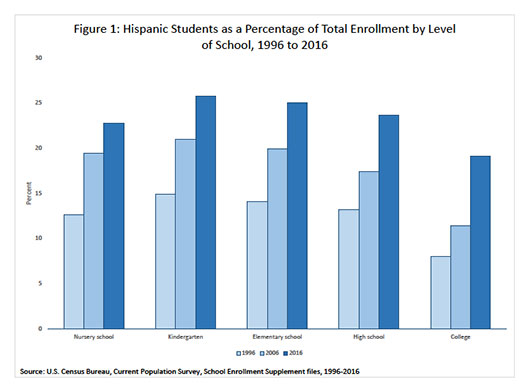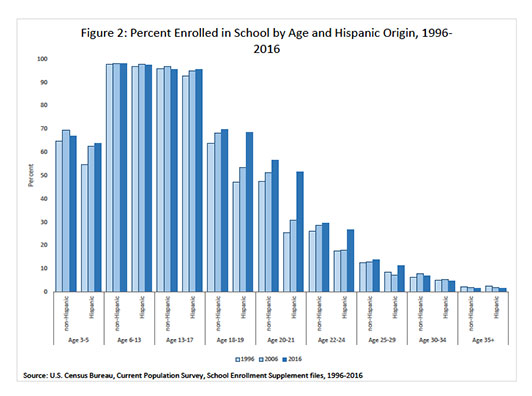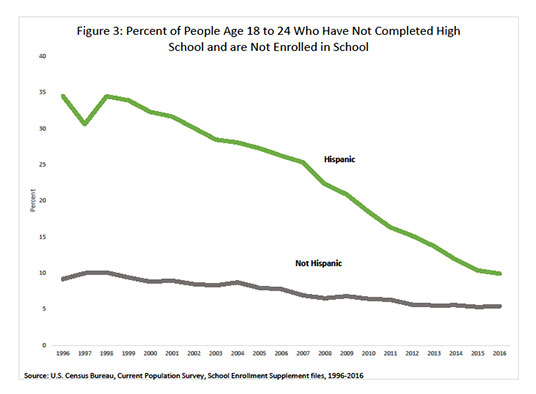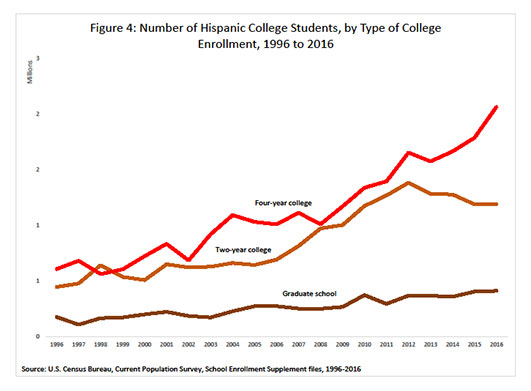
An official website of the United States government
Here’s how you know
Official websites use .gov
A .gov website belongs to an official government organization in the United States.
Secure .gov websites use HTTPS
A lock (
) or https:// means you’ve safely connected to the .gov website. Share sensitive information only on official, secure websites.
-
//
- Census.gov /
- America Counts: Stories /
- Number of Hispanic Students More Than Double in 20 Years
Big Increase in College Enrollment
As the Hispanic population of the United States continues to grow, contributing to more than half of the nation’s population growth the last decade, the number of Hispanic students at all levels of education has doubled in 20 years.
From 1996 to 2016, Hispanic students enrolled in schools from nursery school to college went from 8.8 million to 17.9 million. Hispanics now make up 22.7 percent of all students in the United States.

“The increase in Hispanic enrollment has resulted not only from population growth, but also from increased school attendance rates,’’ said Kurt Bauman, chief of the U.S. Census Bureau’s Education and Social Stratification Branch.
Growth in enrollment rates were especially evident at the youngest ages and the 18- to 24-year-old group, surpassing enrollment growth among non-Hispanics.

At ages 3 to 5, the percentage of Hispanics enrolled grew by 8.8 percentage points compared to a 2.3 point gain for non-Hispanics. At ages 18 to 19, Hispanic enrollment increased 21.4 percentage points (5.9 for non-Hispanics). At ages 20 to 21, the gains were 26.4 percentage points (9.1 for non-Hispanics). The pattern continued for those ages 22 to 24, 9.1 for Hispanics and 3.3 for non-Hispanics.
“The increase in enrollment among young adults is also associated with increases in high school completion and college attendance,” Bauman said.
In 1996, just over a third of 18- to 24-year-old Hispanics had not finished high school and were not attending school. By 2016, the rate had fallen by two-thirds to 9.9 percent.

“The growth in college enrollment among Hispanics has been especially pronounced in the last decade,” Bauman said.
College enrollment went up by 1.7 million from 2006 to 2016, compared to a 700,000 increase the previous 10 years, an overall tripling of Hispanics in college over the past 20 years.
A notable feature of the trend is the large proportion of Hispanic students in two-year colleges. From 2006 to 2011, two-year enrollment grew by nearly 600,000. By 2011, 42.9 percent of Hispanic college students were in two-year schools.
The pattern shifted from 2011 to 2016. Enrollment in two-year colleges held steady while enrollment in four-year colleges grew by almost 700,000.

“In spite of the many positive trends seen here, there are still gaps separating Hispanics from other groups in overall education,” Bauman said.
The proportion of Hispanic 18- to 24-year-olds who have not completed high school and are not in school is still higher than that of non-Hispanics. Enrollment in graduate or professional school also lags that of other groups. Among those ages 25 to 34, graduate school enrollment is 4.2 percent for non-Hispanic whites, 4 percent for blacks, 7.6 percent for Asians and 1.9 percent for Hispanics.
“Nonetheless, the past two decades have seen progress in school enrollment for Hispanics,” Bauman said.
Share
 Yes
Yes
 No
NoComments or suggestions?


Top

